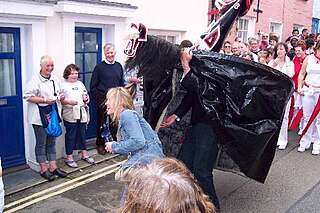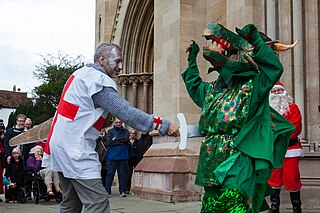Related Research Articles

Hoodening, also spelled hodening and oodening, is a folk custom found in Kent, a county in South East England. The tradition entails the use of a wooden hobby horse known as a hooden horse that is mounted on a pole and carried by a person hidden under a sackcloth. Originally, the tradition was restricted to the area of East Kent, although in the twentieth century it spread into neighbouring West Kent. It represents a regional variation of a "hooded animal" tradition that appears in various forms throughout Britain and Ireland.
Border Morris is a collection of individual local dances from villages along the English side of the Wales–England border in the counties of Herefordshire, Worcestershire and Shropshire. They are part of the Morris dance tradition.

Haslingden is a town in Rossendale, Lancashire, England. It is 16 miles (26 km) north of Manchester. The name means 'valley of the hazels' or 'valley growing with hazels'. At the time of the 2011 census the town had a population of 15,969. The town is surrounded by high moorland; 370 m (1215 ft) to the north; 396 m (1300 ft) Cribden to the east; 418 m (1372 ft) Bull Hill to the south.

Golowan is the Cornish language word for the Midsummer celebrations in Cornwall, UK; widespread prior to the late 19th century and most popular in the Penwith area and in particular Penzance and Newlyn. The celebrations were centred on the lighting of bonfires and fireworks and the performance of associated rituals. The midsummer bonfire ceremonies were revived at St Ives in 1929 by the Old Cornwall Society and since then spread to other societies across Cornwall, as far as Kit Hill near Callington. Since 1991 the Golowan festival in Penzance has revived many of these ancient customs and has grown to become a major arts and culture festival; its central event Mazey Day now attracts tens of thousands of people to the Penzance area in late June.

The Mari Lwyd is a wassailing folk custom found in South Wales. The tradition entails the use of an eponymous hobby horse which is made from a horse's skull mounted on a pole and carried by an individual hidden under a sackcloth.

The 'Obby 'Oss festival is a folk custom that takes place each 1st of May in Padstow, a coastal town in North Cornwall. It involves two separate processions making their way around the town, each containing an eponymous hobby horse known as the 'Obby 'Oss.

In the coastal town of Minehead, located in the southwest English county of Somerset, there is a folk custom on May Day entailing the parading of a brightly decorated hobby horse around the locality.

A soul cake, also known as a soulmass-cake, is a small round cake which is traditionally made for Halloween, All Saints' Day and All Souls' Day to commemorate the dead in many Christian traditions. The cakes, often simply referred to as souls, are given out to soulers who go from door to door during the days of Allhallowtide singing and saying prayers "for the souls of the givers and their friends", especially the souls of deceased relatives, thought to be in Purgatory. The practice in England dates to the medieval period, and was continued there until the 1930s. In Sheffield and Cheshire, the custom has continued into modern times. In Lancashire and in the North-east of England soul cakes were known as Harcakes, a kind of thin parkin.

The Dorset Ooser is a wooden head that featured in the 19th-century folk culture of Melbury Osmond, a village in the southwestern English county of Dorset. The head was hollow, thus perhaps serving as a mask, and included a humanoid face with horns, a beard, and a hinged jaw which allowed the mouth to open and close. Although sometimes used to scare people during practical jokes, its main recorded purpose was as part of a local variant of the charivari custom known as "skimity riding" or "rough music", in which it was used to humiliate those who were deemed to have behaved in an immoral manner.

Mummering is a Christmas-time house-visiting tradition practised in Newfoundland and Labrador, Ireland, City of Philadelphia, and parts of the United Kingdom.

In folklore, a hobby horse is a costumed character that features in some traditional seasonal customs, processions and similar observances around the world. They are particularly associated with May Day celebrations, mummers' plays and the Morris dance in England.

The Britannia Coconut Dancers or Nutters are a troupe of Lancastrian clog dancers who perform every Easter in Bacup, dancing 7 miles (11 km) across the town and surrounding areas after blackening their faces. There are eight dancers and a whipper-in, who controls the proceedings. As the application of blackface is considered offensive and racist, the group is controversial.
The Winster Guisers are a group who perform a traditional mummers play in and around the village of Winster, Derbyshire, UK, during the Christmas season. Their performance is based on a photograph taken c. 1870 outside Winster Hall showing an unidentified set of performers about whom little is known for certain. The Winster Guisers' play is not local to the area, but is a revival of a Cheshire play, chosen because it features a hobby horse similar to the one in the centre of the old photograph. A "guiser" is someone in disguise, though in the Winster area the term was widely used for the teams of Christmas mummers.

Perchtenlaufen is a folk custom found in the Tyrol region of Central Europe. Occurring on set occasions, the ceremony involves two groups of locals fighting against one another, using wooden canes and sticks. Both groups are masked, one as 'beautiful' and the other as 'ugly' Perchte.

Old Tup, sometimes termed the Derby Tup or the Derby Ram, is a folk custom found in an area of the East Midlands of England. Geographically, the custom was found on the borders of Derbyshire and Yorkshire and stretched into part of Nottinghamshire. The tradition entails the use of a hobby horse with a goat's head that is mounted on a pole and carried by an individual hidden under a sackcloth. It represents a regional variation of a "hooded animal" tradition that appears in various forms throughout the British Isles. In geographical location and style it displays strong similarities with the Old Horse custom, but in the latter the hobby horse was presented as a horse rather than a ram.

Old Horse was a folk custom found in an area of north-eastern England. Geographically, the custom was found in Nottinghamshire, Derbyshire, and part of Yorkshire. The tradition entails the use of a hobby horse that is mounted on a pole and carried by an individual hidden under a sackcloth. It represents a regional variation of a "hooded animal" tradition that appears in various forms throughout the British Isles.
The Broad was a folk custom found in the Cotswolds, an area of south-central England, during the nineteenth and early twentieth centuries. The tradition entails the use of a hobby horse with a bull's head that is mounted on a pole and carried by an individual hidden under a sackcloth. It represents a regional variation of a "hooded animal" tradition that appears in various forms throughout the British Isles.
Láir Bhán is a hobby horse that was part of a folk custom found in parts of Ireland, particularly in the area of County Kerry, in the eighteenth and nineteenth centuries.
The Wooing Play was a form of performance found in the folk culture of parts of east-central England.

Mummers' plays are folk plays performed by troupes of amateur actors, traditionally all male, known as mummers or guisers. Historically, mummers' plays consisted of informal groups of costumed community members that visited from house to house on various holidays. Today the term refers especially to a play in which a number of characters are called on stage, two of whom engage in a combat, the loser being revived by a doctor character. This play is sometimes found associated with a sword dance though both also exist in Britain independently.
References
Footnotes
- 1 2 Cawte 1978, p. 142.
- 1 2 3 4 5 6 7 8 9 Cawte 1978, p. 140.
- ↑ Cawte 1978, p. 210.
- ↑ Cawte 1978, pp. 210, 212.
- ↑ Cawte 1978, pp. 94–109.
- ↑ Cawte 1978, pp. 157–177.
- ↑ Hutton 1996, pp. 93–94.
- ↑ Hutton 1996, p. 94.
Bibliography
- Cawte, E. C. (1978). Ritual Animal Disguise: A Historical and Geographical Study of Animal Disguise in the British Isles. Cambridge and Totowa: D.S. Brewer Ltd. and Rowman and Littlefield for the Folklore Society. ISBN 978-0-8599-1028-6.
- Hutton, Ronald (1996). The Stations of the Sun: A History of the Ritual Year in Britain . Oxford: Oxford University Press. ISBN 978-0-1982-0570-8.